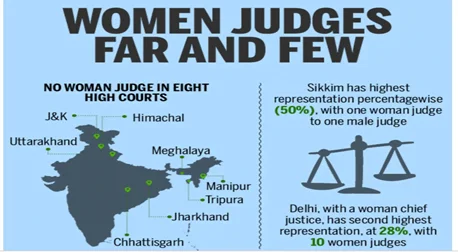Women have played an essential role in the Indian judiciary, yet their representation remains limited. Despite notable contributions, barriers like patriarchy and lack of infrastructure hinder their progress. This overview highlights the current status of women in the judiciary, the challenges they face, and potential measures to enhance their participation and representation.
Empowering Women in Judiciary in India
Present Status of Women in Indian Judiciary
- Supreme Court
-
-
- First Woman Judge: The apex court had its first woman judge in 1989, when Justice M Fatima Beevi was appointed after her retirement as a judge of Kerala High Court.
- Past Facts: The Supreme Court since its inception has seen only 11 women judges in the Supreme Court and no woman as Chief Justice of India for that matter.
- Current Situation: The apex court currently has only three women judges:
-
- Justice Hima Kohli
- Justice B V Nagarathna
- Justice Bela Trivedi
-
- Future Prospect: Justice Nagarathna is expected to become the country’s first woman Chief Justice in 2027.

Enroll now for UPSC Online Course
- High Courts
-
- Present Number of Women Judges: In the High Courts women judges constitute 11.5%.
- Collegium System Recommendations: The Collegium System has recommended 192 candidates so far, but out of these only 37 people i.e. 19% were women.

- Subordinate Courts: The women judicial officers are about 30 percent in the subordinate courts.

- Advocates: Currently there are around 1.7 million advocates out of which only 15% are women.
- Bar Council
- In the State Bar Council, only 2% of the elected representatives are women.
- There is no woman member in the Bar Council of India.
Significance of Women’s Participation in Judiciary

Factors Behind Low Women Representatives In Judiciary
Opaque Functioning of Collegium System: Due to the recruitment through an entrance examination, large number of women tend to enter the lower judiciary at the entry level
- As the higher judiciary follows the collegium system, which tends to be opaque and, therefore, more likely to reflect bias.
- Reservation for Women not at Higher Levels: Various states follow reservation policy for women in the lower judiciary, which is missing in the High Courts and Supreme Court.
- Example: States such as Assam, Andhra Pradesh, Telangana, Odisha and Rajasthan have benefited from such reservation as they now have 40-50% women judicial officers.
- Patriarchy in Society: Patriarchy has become the prime reason for underrepresentation of women in judiciary and it is deeply ingrained in society.
- Problems Faced by Women Lawyers: Women encounter various problems in the courtroom, such as being sexually harassed, disrespected by the lawyers and judges, and ignored in their views on different cases.
- Hurdles of Family Responsibilities: Factors of age and family responsibilities also affects the promotion of women judges from the subordinate judicial services to the higher courts
- Lack of Judicial Infrastructure: It has become the most critical barrier for professional women as there are small courtrooms which are overcrowded and cramped and absence of childcare facilities.
- Shortage of Women in Litigation: The number of women advocates in litigation is quite low in the Supreme Court and High Court as we see from subordinate courts.
Suggestive Measures For Inclusion Of More Women Judges In The Judiciary
As per the recommendations given by Chief Justice of India N.V. Ramana
- 50% Representation: He has voiced support for 50% representation for women in the judiciary.
- Inclusion of Gender Diversification in Legal Education: There is a need to increase gender diversity while providing legal education.
- Number of reserved seats should be fixed for women candidates in all colleges and universities which provide law courses.
- Assurance of Basic Facilities: There is a requirement of basic facilities, especially for women which needs to be addressed immediately.
- Need of Separate Entity: National Judicial Infrastructure Corporation should form a separate entity to include various designs in court complexes and create a more welcoming environment in them.
- Reorienting Education for Work-Life Balance: There should be reorientation of the education system in such a way that it teaches work-life balance such as Child-raising and domestic responsibilities must be meaningfully shared by both men and women.
- Promoting Women Judges in Higher Courts: There is a need for a higher rate of promotion of women judges from lower courts to higher courts.
- Encouraging Female Participation in Court: Judicial benches must encourage young female lawyers’ participation in court to break the myth or perception against female lawyers’ abilities and capabilities.
- Affirmative Action for Women in the Legal Profession: Affirmative action at the bar by ensuring more women as senior advocates, will encourage more women lawyers’ participation.
Enroll now for UPSC Online Course
| Must Read | |
| Current Affairs | Editorial Analysis |
| Upsc Notes | Upsc Blogs |
| NCERT Notes | Free Main Answer Writing |
Conclusion
To achieve a more inclusive judiciary, it’s vital to implement reforms that support women’s representation and address systemic barriers.
- By promoting gender diversity in legal education and ensuring supportive infrastructure, we can empower more women to take on roles in the judiciary.
- Ultimately, a balanced judiciary not only enhances justice but also reflects the diverse society it serves.
Sign up for the PWOnlyIAS Online Course by Physics Wallah and start your journey to IAS success today!
| Related Articles | |
| Exploring the Indian Judiciary: Structure, Significance, & Rule of Law | Bar Council of India: Establishment, Composition, Functions |
| Supreme Court | High Courts in India |

 GS Foundation
GS Foundation Optional Course
Optional Course Combo Courses
Combo Courses Degree Program
Degree Program












